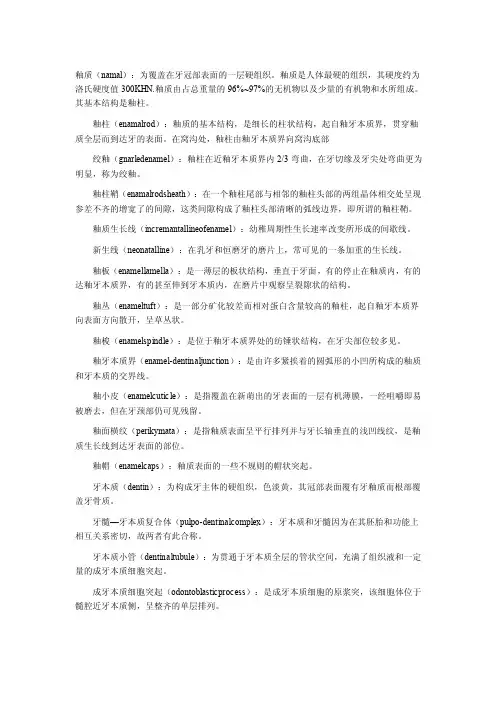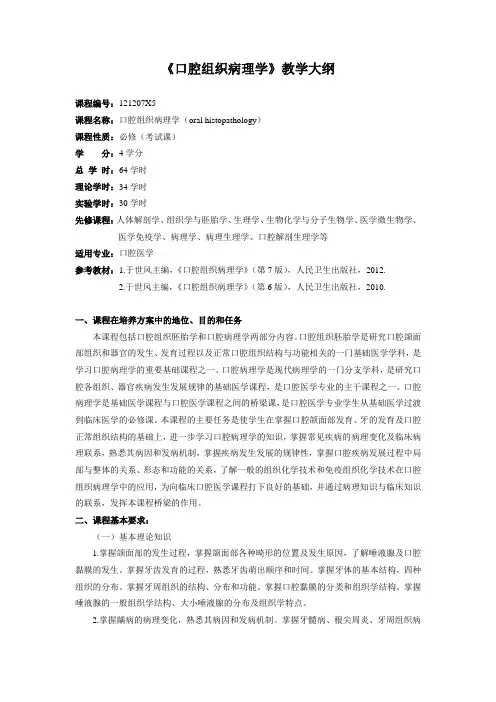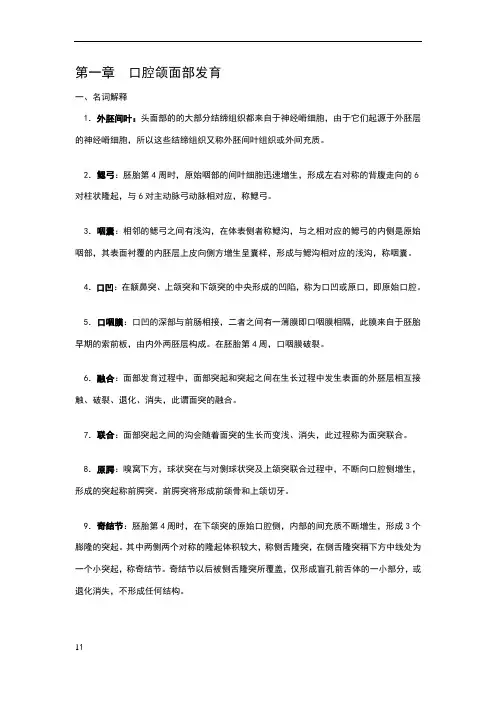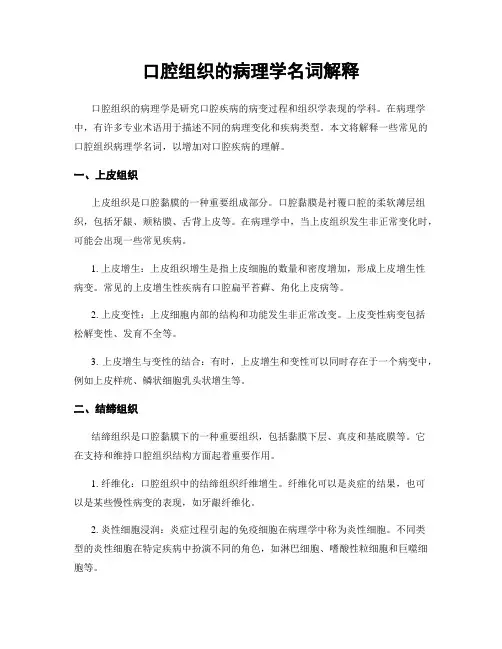口腔组织病理学名解课本
口腔组织病理学名解

釉质(namal):为覆盖在牙冠部表面的一层硬组织。
釉质是人体最硬的组织,其硬度约为洛氏硬度值300KHN.釉质由占总重量的96%~97%的无机物以及少量的有机物和水所组成。
其基本结构是釉柱。
釉柱(enamalrod):釉质的基本结构,是细长的柱状结构,起自釉牙本质界,贯穿釉质全层而到达牙的表面。
在窝沟处,釉柱由釉牙本质界向窝沟底部绞釉(gnarledenamel):釉柱在近釉牙本质界内2/3弯曲,在牙切缘及牙尖处弯曲更为明显,称为绞釉。
釉柱鞘(enamalrodsheath):在一个釉柱尾部与相邻的釉柱头部的两组晶体相交处呈现参差不齐的增宽了的间隙,这类间隙构成了釉柱头部清晰的弧线边界,即所谓的釉柱鞘。
釉质生长线(incremantallineofenamel):幼稚周期性生长速率改变所形成的间歇线。
新生线(neonatalline):在乳牙和恒磨牙的磨片上,常可见的一条加重的生长线。
釉板(enamellamella):是一薄层的板状结构,垂直于牙面,有的停止在釉质内,有的达釉牙本质界,有的甚至伸到牙本质内,在磨片中观察呈裂隙状的结构。
釉丛(enameltuft):是一部分矿化较差而相对蛋白含量较高的釉柱,起自釉牙本质界向表面方向散开,呈草丛状。
釉梭(enamelspindle):是位于釉牙本质界处的纺锤状结构,在牙尖部位较多见。
釉牙本质界(enamel-dentinaljunction):是由许多紧挨着的圆弧形的小凹所构成的釉质和牙本质的交界线。
釉小皮(enamelcutic le):是指覆盖在新萌出的牙表面的一层有机薄膜,一经咀嚼即易被磨去,但在牙颈部仍可见残留。
釉面横纹(perikymata):是指釉质表面呈平行排列并与牙长轴垂直的浅凹线纹,是釉质生长线到达牙表面的部位。
釉帽(enamelcaps):釉质表面的一些不规则的帽状突起。
牙本质(dentin):为构成牙主体的硬组织,色淡黄,其冠部表面覆有牙釉质而根部覆盖牙骨质。
口腔组织病理学PPT课件

05 口腔疾病的诊断与鉴别诊 断
牙周炎的诊断与鉴别诊断
牙周炎的诊断
牙周炎的诊断主要基于患者的临床表现,如牙龈红肿、疼痛、出血、溢脓等, 以及牙周袋形成、牙槽骨吸收等牙周组织的病理变化。
牙周炎的鉴别诊断
牙周炎需要与其他口腔疾病进行鉴别,如牙石、牙龈炎等。其中,牙石可以通 过口腔清洁去除,牙龈炎通常表现为牙龈红肿,但无牙周袋形成和牙槽骨吸收。
牙周炎的治疗与预防
保持口腔卫生
每天刷牙两次,使用牙线和漱口水等,以清除牙菌斑和食物残渣。
控制牙周炎的危险因素
如吸烟、糖尿病等,积极治疗全身性疾病。
定期口腔检查和洁治
每半年到一年进行一次口腔检查和洁治,预防牙周炎的发生。
口腔癌的治疗与预防
手术治疗
对于早期的口腔癌,可能只需要进行 局部的手术治疗。
放疗和化疗
发育异常性疾病:如唇裂、腭 裂等。
其他疾病:如白斑、红斑等癌 前病变。
03 常见口腔疾病病理特点
牙周炎的病理特点
牙周炎是由牙菌斑引起的牙周组织的慢性感染性疾病,主要病理特点是 炎症细胞的浸润和组织破坏。
牙周炎的早期病理表现为牙龈炎症,牙龈水肿、充血、质地松软,易出 血。随着病情发展,炎症逐渐向深部牙周组织扩散,导致牙周膜破坏、
拓展应用领域
将口腔组织病理学的研究成果应用于 口腔疾病的预防、诊断和治疗中,提 高口腔健康水平。
培养专业人才
加强口腔组织病理学专业人才的培养, 提高科研和临床队伍的专业素质和技 术水平。
THANKS FOR WATCHING
感谢您的观看
06 口腔组织病理学展望
口腔组织病理学的研究方向
肿瘤研究
研究口腔肿瘤的发生、发展机 制,寻找有效的早期诊断和治
《口腔组织病理学》教学大纲

《口腔组织病理学》教学大纲课程编号:121207X5课程名称:口腔组织病理学(oral histopathology)课程性质:必修(考试课)学分:4学分总学时:64学时理论学时:34学时实验学时:30学时先修课程:人体解剖学、组织学与胚胎学、生理学、生物化学与分子生物学、医学微生物学、医学免疫学、病理学、病理生理学、口腔解剖生理学等适用专业:口腔医学参考教材:1.于世风主编,《口腔组织病理学》(第7版),人民卫生出版社,2012.2.于世风主编,《口腔组织病理学》(第6版),人民卫生出版社,2010.一、课程在培养方案中的地位、目的和任务本课程包括口腔组织胚胎学和口腔病理学两部分内容。
口腔组织胚胎学是研究口腔颌面部组织和器官的发生、发育过程以及正常口腔组织结构与功能相关的一门基础医学学科,是学习口腔病理学的重要基础课程之一。
口腔病理学是现代病理学的一门分支学科,是研究口腔各组织、器官疾病发生发展规律的基础医学课程,是口腔医学专业的主干课程之一。
口腔病理学是基础医学课程与口腔医学课程之间的桥梁课,是口腔医学专业学生从基础医学过渡到临床医学的必修课。
本课程的主要任务是使学生在掌握口腔颌面部发育、牙的发育及口腔正常组织结构的基础上,进一步学习口腔病理学的知识,掌握常见疾病的病理变化及临床病理联系,熟悉其病因和发病机制,掌握疾病发生发展的规律性,掌握口腔疾病发展过程中局部与整体的关系、形态和功能的关系,了解一般的组织化学技术和免疫组织化学技术在口腔组织病理学中的应用,为向临床口腔医学课程打下良好的基础,并通过病理知识与临床知识的联系,发挥本课程桥梁的作用。
二、课程基本要求:(一)基本理论知识1.掌握颌面部的发生过程,掌握颌面部各种畸形的位置及发生原因,了解唾液腺及口腔黏膜的发生。
掌握牙齿发育的过程,熟悉牙齿萌出顺序和时间。
掌握牙体的基本结构,四种组织的分布。
掌握牙周组织的结构、分布和功能。
掌握口腔黏膜的分类和组织学结构。
口腔组织病理学 名词解释 问答(详细)

第一章口腔颌面部发育一、名词解释1.外胚间叶:头面部的的大部分结缔组织都来自于神经嵴细胞,由于它们起源于外胚层的神经嵴细胞,所以这些结缔组织又称外胚间叶组织或外间充质。
2.鳃弓:胚胎第4周时,原始咽部的间叶细胞迅速增生,形成左右对称的背腹走向的6对柱状隆起,与6对主动脉弓动脉相对应,称鳃弓。
3.咽囊:相邻的鳃弓之间有浅沟,在体表侧者称鳃沟,与之相对应的鳃弓的内侧是原始咽部,其表面衬覆的内胚层上皮向侧方增生呈囊样,形成与鳃沟相对应的浅沟,称咽囊。
4.口凹:在额鼻突、上颌突和下颌突的中央形成的凹陷,称为口凹或原口,即原始口腔。
5.口咽膜:口凹的深部与前肠相接,二者之间有一薄膜即口咽膜相隔,此膜来自于胚胎早期的索前板,由内外两胚层构成。
在胚胎第4周,口咽膜破裂。
6.融合:面部发育过程中,面部突起和突起之间在生长过程中发生表面的外胚层相互接触、破裂、退化、消失,此谓面突的融合。
7.联合:面部突起之间的沟会随着面突的生长而变浅、消失,此过程称为面突联合。
8.原腭:嗅窝下方,球状突在与对侧球状突及上颌突联合过程中,不断向口腔侧增生,形成的突起称前腭突。
前腭突将形成前颌骨和上颌切牙。
9.奇结节:胚胎第4周时,在下颌突的原始口腔侧,内部的间充质不断增生,形成3个膨隆的突起。
其中两侧两个对称的隆起体积较大,称侧舌隆突,在侧舌隆突稍下方中线处为一个小突起,称奇结节。
奇结节以后被侧舌隆突所覆盖,仅形成盲孔前舌体的一小部分,或退化消失,不形成任何结构。
10.Meckel 软骨:也称第1鳃弓软骨或下颌软骨。
分别为左右第1鳃弓中的条形软骨棒。
在发育中,下颌软骨的后端膨大形成锤软骨;下颌软骨耳前区部分还形成锤前韧带和碟下颌韧带,其余部分消失。
二、问答(思考)题1.颌面部常见发育畸形有哪些,其形成背景如何答案要点:唇裂和面裂。
唇裂的形成背景:在上唇是球状突和上颌突未联合或部分联合所致;两侧球状突中央部分未联合或部分联合形成上唇正中裂;两侧下颌突在中线处未联合则形成下唇裂。
口腔组织病理学教材

2口腔上皮3 Nhomakorabea牙周袋袋壁上皮
4
呼吸道上皮
根尖根周尖肉周芽肉肿芽的肿发的展发变展化变化
1.迁延不愈 3.囊肿形成
2.脓肿形成 4.致密性骨炎
2020/9/23
9
由于慢性根尖周炎常常 是继发牙髓病而来,有些 病例又曾有过急性发作, 或有些病例本为急 性根 尖周炎未经彻底治疗而迁 延下来,也有在进行其他 治疗(如义齿修复)时偶然 发现因以往牙髓治疗不完 善所导致的根尖周病变。 所以,在临床上多可追问 出患牙有牙髓病史、反复 肿痛史, 或牙髓治疗史。
慢性根尖周炎分类
口腔组织病理学
慢性根尖周炎
主讲人
慢性根尖周炎
• 慢性根尖周炎(chronic apical periodontitis, CAP)是由于根管内的感染或病原刺激物长期 缓慢刺激而导致的根尖周组织的慢性炎症 反应,常表现为炎性肉芽组织增生和牙槽 骨的破坏,一般无明显症状。
临床表现
1.症状:慢性根尖周炎一 般无明显的自觉症状,有 的患牙可在咀嚼时有不适 感。也有因主诉牙龈起脓 包而就诊者。
2020/9/23
5
病理变化:肉眼观,患牙
根尖部附有一团软 组织,表 面光滑且有被膜,并与牙周膜 相连,可随患牙一同拔出。
2020/9/23
6
新生毛细血管
炎症细胞
增生肉芽 组织团块
淋巴细胞、浆细胞、巨噬细胞、中性粒细胞、 泡沫细胞
镜下 观察
成纤维细胞
根尖周肉芽肿的上皮来源
1
牙周膜Malassez 上皮
㈠根尖周肉芽肿 ㈡慢性根尖周脓肿 ㈢根尖周囊肿
根尖周肉芽肿
根尖周肉芽肿: 常因牙髓的慢性炎症或坏死,是感染通过根尖孔扩散到 根尖周组织引起,也可由急性化脓性根尖周炎转变而来。
口腔组织的病理学名词解释

口腔组织的病理学名词解释口腔组织的病理学是研究口腔疾病的病变过程和组织学表现的学科。
在病理学中,有许多专业术语用于描述不同的病理变化和疾病类型。
本文将解释一些常见的口腔组织病理学名词,以增加对口腔疾病的理解。
一、上皮组织上皮组织是口腔黏膜的一种重要组成部分。
口腔黏膜是衬覆口腔的柔软薄层组织,包括牙龈、颊粘膜、舌背上皮等。
在病理学中,当上皮组织发生非正常变化时,可能会出现一些常见疾病。
1. 上皮增生:上皮组织增生是指上皮细胞的数量和密度增加,形成上皮增生性病变。
常见的上皮增生性疾病有口腔扁平苔藓、角化上皮病等。
2. 上皮变性:上皮细胞内部的结构和功能发生非正常改变。
上皮变性病变包括松解变性、发育不全等。
3. 上皮增生与变性的结合:有时,上皮增生和变性可以同时存在于一个病变中,例如上皮样疣、鳞状细胞乳头状增生等。
二、结缔组织结缔组织是口腔黏膜下的一种重要组织,包括黏膜下层、真皮和基底膜等。
它在支持和维持口腔组织结构方面起着重要作用。
1. 纤维化:口腔组织中的结缔组织纤维增生。
纤维化可以是炎症的结果,也可以是某些慢性病变的表现,如牙龈纤维化。
2. 炎性细胞浸润:炎症过程引起的免疫细胞在病理学中称为炎性细胞。
不同类型的炎性细胞在特定疾病中扮演不同的角色,如淋巴细胞、嗜酸性粒细胞和巨噬细胞等。
3. 血管扩张:与炎症相关的血管扩张,使得血管及其内壁产生扩张和充血。
血管扩张是炎症过程中病变组织常见的表现之一。
三、肿瘤口腔肿瘤是指在口腔组织中发生的异常细胞生长和组织增殖。
它们可以是良性的(非癌性)或恶性的(癌症)。
这些肿瘤根据其来源和组织学特点进行分类。
1. 白斑:口腔黏膜上的表浅白色病变。
白斑有潜在发展为癌症的可能性。
2. 扁平苔藓:一种良性上皮增生性病变。
它通常表现为口腔黏膜上的白色斑块。
3. 纤维性肿瘤:一类由结缔组织细胞增生形成的良性肿瘤。
口腔中的一种常见纤维性肿瘤是牙源性囊肿。
4. 癌症:口腔组织中最严重的肿瘤类型之一。
口腔组织病理学名解(课本)
25. 嗅囊:胚胎第六周时,由于侧鼻突、上颌突向中线方向生长,将中鼻突的两个球状突向中线推移,并使其相互联合,使鼻凹外口不断抬高,变成了一个盲囊,称嗅囊,以后与口腔相通。
第一章 “口腔颌面部结缔组织都来自于神经嵴细胞,由于它们起源于外胚层的神经嵴细胞,所以这些结缔组织又称外胚间叶组织或外间充质。
2.鳃弓:胚胎第4周时,原始咽部的间叶细胞迅速增生,形成左右对称的背腹走向的6对柱状隆起,与6对主动脉弓动脉相对应,称鳃弓。
3.咽囊:相邻的鳃弓之间有浅沟,在体表侧者称鳃沟,与之相对应的鳃弓的内侧是原始咽部,其表面衬覆的内胚层上皮向侧方增生呈囊样,形成与鳃沟相对应的浅沟,称咽囊。
26. 侧腭突或继发腭:胚胎第6周末,从左右两个上颌突的口腔侧中部向原始口腔内各长出一个突起,称侧腭突或继发腭。
27. 腭裂:是口腔较常见的畸形,为一侧侧腭突和对侧侧腭突及鼻中隔未融合或部分融合的结果。
28. 颌裂:颌裂可发生于上颌,也可发生于下颌,但上颌裂较常见。上颌裂为前腭突与上颌突未能联合或部分联合所致,常伴有唇裂或腭裂。 下颌裂为两侧下颌突未联合或部分联合的结果。
14.管周牙本质:镜下观察牙本质的横剖磨片时,可清楚地见到围绕成牙本质细胞突起的间质与其余部分不同,呈环形的透明带,称为管周牙本质,它构成牙本质小管的壁。管周牙本质矿化程度高,含胶原纤维极少。
15.管间牙本质:位于管周牙本质之间。其内胶原纤维较多,基本上为I型胶原,围绕小管成网状交织排列,并与小管垂直,其矿化程度较管周牙本质低。
口腔组织病理学名词解释
口腔组织病理学名词解释
口腔组织病理学是研究口腔疾病病因、发病机制、病理变化及转归的学科,对于口腔疾病的诊断、治疗和预防具有重要意义。
以下是关于口腔组织病理学的名词解释,涵盖了口腔黏膜、牙周组织、唾液腺、牙髓、牙龈炎、牙周炎和口腔癌等方面。
1. 口腔黏膜:口腔黏膜是覆盖在口腔表面的组织结构,包括唇、颊、舌、腭、口底等部位的黏膜。
口腔黏膜具有保护口腔、感受刺激、分泌唾液等功能。
2. 牙周组织:牙周组织是围绕牙齿的支持组织,包括牙龈、牙周膜、牙槽骨等。
牙周组织对于维持牙齿的稳固和正常功能具有重要作用。
3. 唾液腺:唾液腺是分泌唾液的腺体,包括腮腺、颌下腺、舌下腺等。
唾液具有消化、抗菌、保护口腔黏膜等作用。
4. 牙髓:牙髓是牙齿内部的软组织,主要功能是营养和支持牙齿,并感受牙齿的冷、热、酸、甜等刺激。
5. 牙龈炎:牙龈炎是牙龈组织的炎症性疾病,主要症状包括牙龈红肿、出血、口臭等。
牙龈炎如果不及时治疗,可能发展为牙周炎。
6. 牙周炎:牙周炎是牙周组织的炎症性疾病,主要症状包括
牙龈红肿、疼痛、溢脓等。
牙周炎会导致牙槽骨吸收和牙齿松动,严重时可导致牙齿脱落。
7. 口腔癌:口腔癌是发生在口腔黏膜或颌骨上的恶性肿瘤,包括唇癌、舌癌、口底癌等。
口腔癌的病因包括长期吸烟、饮酒、紫外线照射等。
《口腔组织病理学》课程教学大纲
《口腔组织病理学》课程教学大纲一、课程基本信息二、课程简介:《口腔组织病理学》(Oral Histopathology)是口腔医学重要的基础学科,是口腔专业临床与基础医学之间的桥梁课;是口腔医学专业学生从普通医学过渡到口腔医学中的必修课,对正确认识、理解和掌握口腔疾病发生、发展规律至关重要。
三、教学目标与要求通过教学,要求学生掌握口腔医学基础理论、基本知识和基本技能的训练,充分发挥学生学习的主动性、积极性,注意培养学生分析问题和解决问题的能力。
四、教材及参考书(一)教材名称及性质于世凤主编《口腔组织病理学》第7版,人民卫生出版社(二)参考书五、课程考核方式(一)考核方式过程考核(考勤、作业),课终考核(闭卷)(二)成绩评定办法成绩构成:课终考核成绩×60% + 过程考核成绩40%六、课外学习要求课外学习(自学)要求,特别是对作业的要求,说明作业的形式(如习题、报告等)、作业量、以及对作业完成时间要求等。
第一章口腔颌面部的发育1.目的要求:掌握神经嵴的分化、腮弓和咽囊的部位及概念。
熟悉腮弓和咽囊的发育。
了解神经嵴细胞的分布对头颈部发育的重要性。
掌握面部的发育过程及面部发育异常。
掌握腭部的发育过程及发育异常。
掌握舌的发育过程及舌的发育异常。
了解涎腺的发育及口腔粘膜的发育。
掌握下颌骨的发育。
熟悉上颌骨的发育及颞下颌关节的发育。
了解颌骨发育的调控。
2.学时分配:讲授2学时3.教学重点:(一)神经嵴的分化、腮弓和咽囊的部位及概念。
(二)面部的发育过程及面部发育异常。
(三)腭部的发育过程及发育异常。
(四)下颌骨的发育。
4.教学难点:(一)神经嵴的分化、腮弓和咽囊的部位及概念。
(二)面部的发育过程及面部发育异常。
5.教学内容:(一)神经嵴的分化、腮弓和咽囊的部位及概念。
腮弓和咽囊的发育。
神经嵴细胞的分布对头颈部发育的重要性。
(二)面部的发育:面部的发育过程及面部发育异常。
(三)腭的发育:腭部的发育过程及发育异常。
口腔组织病理学名词解释(Anex...
口腔组织病理学名词解释(An explanation of the terms of oralhistopathology)1. ecto mesenchymal: the head and face most of the connective tissue from neural crest cells, neural crest cells because they originate from the ectoderm, so these connective tissue called ecto mesenchymal tissues or mesenchymal.2. branchial arch: when the embryo is fourth weeks old, the primary pharyngeal mesenchymal cells proliferate rapidly, forming a symmetrical 6 dorsal column with a symmetrical dorsal horn, which corresponds to the 6 pairs of the aortic arch arteries, called the branchial arch.3.: a shallow trench between the pharyngeal branchial arch on the surface adjacent to the side that branchial, medial and branchial arch corresponding to the original surface of the pharynx, lined by endoderm epithelium with cystic hyperplasia of the laterally, forming a shallow trench should be opposite branchial groove, called pharyngeal pouch.4. concave: in the nose, the maxillary process and the mandibular process of the central formation of depression, known as the mouth of the mouth or mouth, that is, the original oral cavity.5.: oropharyngealmembrane stomodeal deep and connected with a film that foregut, oropharyngealmembrane apart between the two, this film from the prochordal plate early embryo, consisting of two layers inside and outside. At the end of the fourth week of the embryo, the oropharynx membrane ruptures.6. fusion: in the process of facial development, the facial ectoderm and the process of growth occur in the process of surface ectoderm contact, rupture, degradation and disappearance, which is called the fusion of facial processes.7. joint: the process of facial protuberance will become shallow and disappear with the growth of facial process. This process is called facial protrusion.8., the original palate: under the olfactory pit, the bulbous protrusion is constantly proliferating to the oral side during the process of combining with the contralateral bulbous protrusion and the maxillary process. The protrusion is called the palatal protrusion. The anterior palatine process will form the maxillary and maxillary incisors.9. nodules: at fourth weeks of embryo, the inner mesenchyme of the mandible is constantly proliferating, forming 3 bulging processes. The two symmetrical eminence on both sides of the tongue is larger, called the lateral lingual eminence, and it is a small protuberance at the midline of the lateral lingual eminence, called the singular nodule. After the nodules are covered by the lateral lingual protuberance, only a small part of the anterior tongue of the foramen is formed, or it degenerates and disappears without forming any structure.10.Meckel cartilage: also called first branchial arch cartilage or mandibular cartilage. Bar cartilage bars in the left and right first branchial arches, respectively. During development, the posterior end of the mandibular cartilageexpands to form a hammer cartilage; the anterior part of the mandibular cartilage also forms the anterior and lower jaw ligaments, and the rest of the cartilage disappears.1. primary belt: embryonic fifth weeks, in the alveolar area in the future, deep ecto mesenchymal tissue induced epithelial hyperplasia, started only at specific points on the mandibular arch on local epithelial hyperplasia, epithelial thickening quickly connect to each other in accordance with the shape of a horseshoe shaped jaw formed on the belt. Known as the primary belt.2. plates: in the seventh week of the embryo, the primary upper belt continues to grow deep and divides into two: the epithelial plate that grows toward the buccal (LIP) direction is called the vestibular plate, and the epithelial plate on the lingual (palatal) side is called the dental plate.3. epithelial septum: the epithelial root sheath continues to grow, leaving the crown about 450 degrees toward the pulp direction, forming a disk like structure. This part of the epithelium is called the epithelial septum. The epithelial septum is surrounded by an open pore to the pulp, which is the apical foramen of the future.4. epithelial root sheath: root starts to occur, the inner enamel and outer enamel epithelium hyperplasia in the cervical loop, growth to apical direction, and reticular layer and the middle layer cells do not appear in the hyperplastic epithelium. These hyperplastic epithelia form a double layer called the epithelial root sheath.5. neck ring: the inner enamel epithelium is connected with the outer enamel epithelium and is called the cervical ring. It plays an important role in the formation of the epithelial root sheath.6. enamel junction: in the middle of the tooth germ, the local thickening of the inner enamel epithelium and the enamel knot play an important role in the morphogenesis of the teeth, and may be the signal center for regulating cell differentiation and tooth morphogenesis.7. reduced enamel epithelium: enamel after ameloblasts, middle layer cells and stellate reticulum and the outer enamel epithelium, forming a layer of squamous epithelium covering the enamel cuticle, called the reduced enamel epithelium (reduced dental epithelium). When the teeth erupt into the mouth, the reduced enamel epithelium forms the junctional epithelium of the gum at the neck of the tooth.8. guide tube: when the tooth germ meets the direction of the joint, the tooth capsule surrounding the tooth germ is connected with the lamina propria of the oral mucosa through connective tissue cord. This structure is called the guide cord. In the dry skull of the baby, the pores of the connective tissue line are visible on the lingual side of the primary teeth, referred to as the "guide tube". When the permanent teeth erupt, the bone absorption soon leads to the widening of the guide tube and becomes the bone channel for the eruption of teeth.1. inter ball dentin: the dentin is mainly spherical andcalcified and consists of many calcium globules. In the absence of dentin calcification, the calcified globules leave a number of calcified stroma known as inter - dentin, where the dentin tubules are passed, but there is no periodontal dentin structure. The inter - dentin is mainly seen near the crown of tooth and the dentin border,The distribution of teeth along the growth line, size, irregular shape, and its edge is concave, much like the gap between many spheres.2. prophase dentin: there is always a layer of mineralized dentin between the odontoblast and mineralized dentin, called pre dentin. The initial dentin is generally 10~12 m thick. The teeth of the developing teeth become slower than those of the developing teeth, so the anterior dentin of the former is thinner than the latter. The boundary between the early dentin and mineralized dentin is clear, irregular shape shows calcified globules.3. reparative dentin: also referred to as third - phase dentin or reactive dentin. When the enamel surface is damaged by wear, acid etching and caries, the deep dentin is exposed, and the dentin cells are stimulated by varying degrees, and some of them are denatured. Pulp deep undifferentiated cells can be moved to the place and the degeneration of cells to differentiate into odontoblasts, and odontoblasts and still function together with the secretion of dentin matrix, and mineralization, called reparative dentin.4. secondary dentin: the development of the tooth root, theocclusal relationship between the teeth and the pair of teeth, the secondary dentin is formed after the tooth is formed. Secondary teeth have been reported to have secondary dentine formation. Secondary dentin is essentially an age-related change in dentin, and its formation rate is slower.5. duct dentin: located between the periodontal dentin. There are more collagen fibers in it, basically collagen type I, which is arranged around the tubules and arranged in a network, and it is perpendicular to the tubules, and the mineralization is lower than that of the periodontal dentin.6.: To observe the peritubular dentin dentin section disc under microscope, can be clearly seen around the odontoblast processes of interstitial and rest, annular transparent tapes, called peritubular dentin, which constitutes the dentinal tubule wall. The periodontal dentin is highly mineralized and contains very little collagen fibrils.7. cover: the first formed close to the dentin enamel and cementum layer of primary dentin, the collagen fibers were mainly from incompletely differentiated into secretory odontoblasts Korff (Korff) and collagen fiber, arranged in parallel tubular. The crown tooth is called the dentin.8.: when the transparent dentin dentin under wear and slow development of caries after stimulation, in addition to the formation of reparative dentin, may also cause the dentinal tubules of odontoblast processes occur degeneration, degeneration after mineral salt calm and mineralization of closed tubules, which can prevent the outside stimulation ofafferent pulp at the same time, the collagen fiber tube week can also occur degeneration. Because of the refraction of tubules and surrounding stroma was no significant difference, so in the slices are transparent and are called transparent dentin.9. (dentin) transparent layer: the first formed close to the enamel and cementum layer of primary dentin, the collagen fibers were mainly from incompletely differentiated into secretory odontoblasts Korff (Korff) and collagen fiber, arranged in parallel tubular. In the crown, the dentin is called the dentin, and the root is called a transparent layer with a thickness of about 5~10 M.10. tomes granular layer: in tooth profile grinding in a layer of granular non mineralized area inside the transparent layer of root dentin, called tomes granular layer.11., dead zone: because of wear, acid etching or caries, such as heavier stimulation, so that the tubules of the odontoblast cell gradually evolved, and decomposition, filled with air inside the tube. Under transmission light microscopy, this part of the dentin is black, called the dead zone. This region is less sensitive and is common in narrow medullary angles. The periphery of the dead zone is surrounded by a transparent dentin, and the restored dentin at the proximal end of the bone is visible.1. color: pink color attached gingiva, resilient, surface is orange peel, there are many punctate depressions called stippling. Stippling can enhance gingival resistance tomechanical friction, but in inflammatory edema, the surface can disappear and become bright color.2. main fibers: the collagen in the periodontal ligament is synthesized by fibroblasts, which are synthesized by extracellular polymerization, and they are deposited into large fiber bundles and arranged in a certain direction, which is called the main fiber.3. epithelial remnant: in the periodontal ligament, the small epithelial cords or epithelial masses are seen in the fibrous spaces adjacent to the root surface, parallel to the root surface, also known as the Malassez epithelial remnant. This is the root development stage on the residual epithelial root sheath epithelial cells. Under light microscopy, the cells were smaller, cubic or oval, with less cytoplasm and basophilic staining. The basement membrane of the electron microscope showed that the cells were separated from the matrix of the periodontal ligament. The adjacent cells were connected by desmosomes, and the cytoplasm contained a large number of actin filaments and a large number of ribosomes. Normally, the epithelium remains quiescent and, when stimulated by inflammation, epithelial proliferation becomes the source of jaw cysts and odontogenic tumors.FourBundle bone: because there are a large number of exogenous collagen fibers embedded, so the inherent alveolar bone, also known as the bundle bone.5. (alveolar bone) through fiber: proper alveolar bone and periodontal ligament were adjacent side plate layers, which embedded in the periodontal membrane fiber is a penetrating fiber, its direction and vertical bone plate or a certain angle, inherent in alveolar bone through fiber cementum in wear through the crude fiber.1.. Acquired membranes: also called salivary membranes, which are formed by the selective adsorption of saliva glycoproteins on the tooth surface. Its thickness is about 30~60 mu m, it can be formed in 20 minutes after cleaning and polishing of tooth surface. It is stable in 1~2 hours.2.: the bacterial plaque is not mineralized by sediment, bacteria, and bacterial salivary glycoprotein extracellular polysaccharide (mainly glucan and fructan) plaque matrix composed, which also contains a small amount of exfoliated epithelial cells, white blood cells, food etc.. Bacterial plaque is a microbial ecological environment. Bacteria grow, develop, reproduce and decline in this environment. They are complex metabolic activities. They are complex biofilms arranged in space.3. demineralization: loss of mineral ions and dissolution of hydroxyapatite crystals4. remineralization: the mineral ions re deposit and the crystals re form5.: static caries caries process, because the environment changes, the tooth surface easy to clean, the lesions in contactwith saliva, the disease slows down, the final is in stationary state, no further progress trend, this is a static dental caries. It can be seen in enamel caries, dentin caries and root caries. The quiescent caries is shallow, with a large and shallow outer surface, and is hard and Tan due to the deposition of mineral salts and pigments in the saliva. Microscopically, the surface of the dentinal tubules is in a neat section with remineralization on the surface, and there is a reparative dentin on the side of the medullary cavity.6.: undermining caries fissure caries lesion is not starting from the bottom, but a ring around the progress of fissure wall, and along the direction of long axis of enamel rod extends to depth, when disease progression over the nest ditch bottom, side wall of mutual integration. Because the arrangement of enamel columns near the pit and fissure is concentrated at the bottom of the pit, the formation of caries and morphology is consistent with the arrangement of the glaze columns.Noun interpretation1. dental pulp network atrophy: because the pulp blood supply is insufficient, the pulp tissue has the varying size vacuolar gap, which is full of the liquid. The dental pulp cell is reduced, the odontoblast, the blood vessel and the nerve disappear, and the pulp has a fibrous reticular formation, which is called pulp reticular atrophy.2. calcoid: Chronic hyperplastic pulpitis is more common in children and adolescents, often occur in primary molars or first molars. The affected teeth have larger puncture holes,large apical pores and abundant pulp blood supply, which makes the inflammatory pulp tissue increase in polyp form, and the perforation is prominent through the perforation of the pulp, which is also called dental pulp polyp.3. pulp calcification: refers to the pulp tissue due to malnutrition or tissue degeneration, and on this basis, calcium salts deposited by the formation of unequal sizes of calcified mass. There are two forms of pulp calcification. One is called intramedullary. It is seen in the pulp chamber, and the other is called diffuse calcification. The calcification is mostly scattered in the root canal.4. pulp fiber changes: because the pulp blood supply is insufficient, the pulp cell, the blood vessel, the nerve atrophy reduces or vanishes, the fiber ingredient increases. Thick collagen fibers parallel to the long axis of the pulp or showing a homogeneous, red stained glassy degeneration known as pulp fibrosis. More common in the pulp of the elderly.5. pulpitis: pulp hyperemia, if the removal of the cause, such as dental caries or wedge-shaped defects such as timely treatment, the pulp can be restored to normal state of congestion. So the pathological hyperemia pulp called pulpitis.6. residual pulpitis: chronic pulpitis is a special type of residual pulpitis occurred in inflammation remains in the pulp tissue of root canal. Residual pulpitis often occurs in months or even years after mummification of pulp, followed by the failure of the bone marrow with a broken pulp. When the pulpis plasticized or incomplete, the root canal in the root canal treatment may be secondary to residual pulpitis.7. internal resorption: refers to the absorption from the inner wall of the pulp cavity toward the surface of the tooth. Internal resorption may be due to certain stimuli and the pulp is replaced by inflammatory granulation tissue. Odontoblast and prophase dentin destroy and lose barrier function. The release of prostaglandins and interleukin in inflammatory granulation tissue activates osteoclasts and leads to absorption from the inner wall of the medullary cavity from the inside to the outside.。
- 1、下载文档前请自行甄别文档内容的完整性,平台不提供额外的编辑、内容补充、找答案等附加服务。
- 2、"仅部分预览"的文档,不可在线预览部分如存在完整性等问题,可反馈申请退款(可完整预览的文档不适用该条件!)。
- 3、如文档侵犯您的权益,请联系客服反馈,我们会尽快为您处理(人工客服工作时间:9:00-18:30)。
口腔组织病理学名解(课本)第一章“口腔颌面部发育”1.外胚间叶:头面部的的大部分结缔组织都来自于神经嵴细胞,由于它们起源于外胚层的神经嵴细胞,所以这些结缔组织又称外胚间叶组织或外间充质。
2.鳃弓:胚胎第4周时,原始咽部的间叶细胞迅速增生,形成左右对称的背腹走向的6对柱状隆起,与6对主动脉弓动脉相对应,称鳃弓。
3.咽囊:相邻的鳃弓之间有浅沟,在体表侧者称鳃沟,与之相对应的鳃弓的内侧是原始咽部,其表面衬覆的内胚层上皮向侧方增生呈囊样,形成与鳃沟相对应的浅沟,称咽囊。
4.口凹(原口):在额鼻突、上颌突和下颌突的中央形成的凹陷,称为口凹或原口,即原始口腔。
5.口咽膜:口凹的深部与前肠相接,二者之间有一薄膜即口咽膜相隔,此膜来自于胚胎早期的索前板,由内外两胚层构成。
在胚胎第4周,口咽膜破裂。
6.融合:面部发育过程中,面部突起和突起之间在生长过程中发生表面的外胚层相互接触、破裂、退化、消失,此谓面突的融合。
7.联合:面部突起之间的沟会随着面突的生长而变浅、消失,此过程称为面突联合。
8.原腭:嗅窝下方,球状突在与对侧球状突及上颌突联合过程中,不断向口腔侧增生,形成的突起称前腭突。
前腭突将形成前颌骨和上颌切牙。
9.奇结节:胚胎第4周时,在下颌突的原始口腔侧,内部的间充质不断增生,形成3个膨隆的突起。
其中两侧两个对称的隆起体积较大,称侧舌隆突。
在侧舌隆突稍下方中线处为一个小突起,称奇结节。
10.Meckel 软骨:也称第1鳃弓软骨或下颌软骨。
分别为左右第1鳃弓中的条形软骨棒。
在发育中,下颌软骨的后端膨大形成锤软骨;下颌软骨耳前区部分还形成锤前韧带和碟下颌韧带,其余部分消失。
11. 神经嵴:神经板在发育中,外侧缘隆起,神经板的中轴处形成凹陷称神经沟,隆起处称神经褶。
神经褶的顶端与周围外胚层交界处称神经嵴。
12. 神经嵴细胞:在胚胎第4周,两侧神经褶在背侧中线汇合形成神经管的过程中,位于神经嵴处的神经外胚层细胞,未进入神经管壁,而是离开神经褶和外胚层进入中胚层,这部分细胞即神经嵴细胞。
13. 颈窦:第2腮弓生长速度快,朝向胚胎的尾端,并覆盖了2、3、4腮沟和3、4、5腮弓,并与颈部组织融合。
被覆盖的腮沟与外界隔离,形成一个暂时的由外胚层覆盖的腔称为颈窦。
颈窦在以后的发育中消失。
14. 额鼻突:胚胎第3周,发育中的前脑下端出现了一个突起称额鼻突。
15.上颌突:胚胎的第4周,下颌突两侧的上方区域的间充质长出两个分支状突起,称上颌突。
16. 拉特克囊:约在胚胎第3周末,在口咽膜前方口凹顶端正中出现一个囊样内陷,称拉特克囊。
17. 颅咽管:拉特克囊与原口上皮间有上皮性柄相连,囊的起点由于原口的发育,最后位于鼻中隔后缘,此后上皮性柄和拉特克囊退化消失,此囊的残余称颅咽管。
18. 鼻板:胚胎第4周,口咽膜破裂。
口腔与前肠相通。
同时,额鼻突的末端两侧的外胚层上皮出现椭圆形局部增厚区,称嗅板或鼻板。
鼻板细胞形成鼻粘膜及嗅神经上皮。
19. 鼻凹或嗅窝:由于细胞的增生使鼻板中央凹陷,称鼻凹或嗅窝。
鼻凹将来发育成鼻孔。
20. 侧鼻突:嗅窝两侧的2个突起称侧鼻突。
21. 中鼻突:两个嗅窝之间的突起称中鼻突。
22. 球状突:胚胎第5周,中鼻突生长迅速,其末端出现两个球形突起称球状突。
23. 唇裂:唇裂多见于上唇,是由于球状突和上颌突未联合或部分联合所致。
此种唇裂发生在唇的侧方,可以是单侧的,也可以是双侧的,单侧者较多。
两侧球状突中央部分未联合或部分联合形成上唇正中裂;两侧下颌突在中线处未联合则形成下唇裂,这两种唇裂罕见。
24. 面裂:上颌突与下颌突未联合或部分联合将发生横面裂,裂隙可自口角至耳屏前,较轻微者可为大口畸形;如联合过多则形成小口畸形。
上颌突与侧鼻突未联合将形成斜面裂,裂隙自上唇沿着鼻翼基部至眼睑下缘。
还有一种极少见的情况,因侧鼻突与中鼻突之间发育不全,在鼻部形成纵行的侧鼻裂。
25. 嗅囊:胚胎第六周时,由于侧鼻突、上颌突向中线方向生长,将中鼻突的两个球状突向中线推移,并使其相互联合,使鼻凹外口不断抬高,变成了一个盲囊,称嗅囊,以后与口腔相通。
26. 侧腭突或继发腭:胚胎第6周末,从左右两个上颌突的口腔侧中部向原始口腔内各长出一个突起,称侧腭突或继发腭。
27. 腭裂:是口腔较常见的畸形,为一侧侧腭突和对侧侧腭突及鼻中隔未融合或部分融合的结果。
28. 颌裂:颌裂可发生于上颌,也可发生于下颌,但上颌裂较常见。
上颌裂为前腭突与上颌突未能联合或部分联合所致,常伴有唇裂或腭裂。
下颌裂为两侧下颌突未联合或部分联合的结果。
29. 侧舌隆突:在胚胎第4周时,两侧第一、二腮弓在中线处联合。
此时,在下颌突的原始口腔侧,内部的间充质不断增生,形成三个膨隆的突起。
其中两侧两个对称的隆起体积较大,称侧舌隆突。
30. 联合突:在第二、三、四腮弓的口咽侧,奇结节的后方,间充质增生形成一个突起称联合突,主要由第三腮弓形成。
31. 界沟:联合突向前生长并越过第二腮弓与舌的前2/3联合,形成甲舌的后1/3即舌根。
联合线处形成一个浅沟称界沟。
32. 甲状舌管:甲状腺发育自奇结节和联合突之间中线处的内胚层上皮。
胚胎第4周,此处上皮增生,形成管状上皮条索,称甲状舌管。
33.舌盲孔:胚胎第6周甲状舌管逐渐退化,与舌表面失去联系。
但在其发生处的舌背表面留下一浅凹,即舌盲孔,位于界沟的顶端。
34. 正中菱形舌:在舌盲孔前方,有时可见小块菱形或椭圆形红色区域。
此区域的舌乳头呈不同程度的萎缩,称为正中菱形舌。
第二章“牙的发育”1.原发性上皮带:胚胎的第5周,在未来的牙槽突区,深层的外胚间叶组织诱导上皮增生,开始仅在上下颌弓的特定点上,上皮局部增生,很快增厚的上皮互相连接,依照颌骨的外形形成一马蹄形上皮带,称为原发性上皮带。
2.牙板:在胚胎的第7周,原发性上皮带继续向深层生长,并分裂为两个:向颊(唇)方向生长的上皮板称前庭板,位于舌(腭)侧的上皮板称为牙板。
3. 牙囊:牙囊是包绕成釉器和牙乳头的外胚间叶组织。
4. 牙胚:牙板向深层的结缔组织内伸延,在其最末端细胞增生,进一步发育成牙胚。
牙胚由三部分组成:(1)成釉器,起源于口腔外胚层,形成釉质;(2)牙乳头,起源于外胚间充质,形成牙髓和牙本质;(3)牙囊,起源于外胚间充质,形成牙骨质,牙周膜和固有牙槽骨。
5.上皮隔:上皮根鞘持续生长,离开牙冠向牙髓方向呈约450角弯曲,形成一盘状结构。
弯曲的这一部分上皮称上皮隔。
上皮隔围成一个向牙髓开放的孔,是未来的根尖孔。
6.上皮根鞘:牙根开始发生时,内釉和外釉上皮细胞在颈环处增生,向未来的根尖孔方向生长,而星网状层和中间层细胞并不出现在上述增生的上皮中。
这些增生的上皮成双层,称为上皮根鞘。
7.颈环:内釉上皮与外釉上皮相连处称颈环,在上皮根鞘的发生中起重要作用。
8.釉结:在牙胚中央,内釉上皮局部的增厚,釉结在牙形态发生中有重要作用,可能是调节细胞分化和牙形态发生的信号中心。
9. 釉索:是由釉结向外釉上皮走行的一条细胞条索,似乎将成釉器一分为二。
10.釉龛:是由于片状的牙板向内凹形成腔隙,内充满结缔组织.11. Serre上皮剩余(Serre腺):有时有些残留的牙板上皮,以上皮岛或上皮团的形式存在于颌骨或牙龈中,由于这些上皮细胞团类似于腺体,又称为Serre腺或Serre上皮剩余。
12. 基质小泡:在成牙本质细胞突起形成的同时,细胞浆中出现一些膜包被的小泡,称为基质小泡。
13.托姆斯突(Tomes processes):无釉柱结构的釉质形成后,成釉细胞开始离开牙本质表面,在靠近釉牙本质界的一端,形成短的圆锥状突起,称为托姆斯突。
14.缩余釉上皮:釉质发育完成后,成釉细胞、中间层细胞和星网状层与外釉上皮细胞结合,形成一层鳞状上皮覆盖在釉小皮上,称为缩余釉上皮(reduced dental epithelium)。
当牙萌出到口腔中,缩余釉上皮在牙颈部形成牙龈的结合上皮。
15. 釉小皮:在牙冠形成后,成釉细胞变短,细胞器的数量减少,在釉质表面分泌一层无结构的有机物薄膜覆盖在牙冠表面上,称为釉小皮。
16. 马拉瑟上皮剩余(Malassez epithelial rest):剩余的上皮细胞进一步离开牙根表面,并保留在发育的牙周膜中,这是上皮剩余,也叫马拉瑟上皮剩余。
17.引导管(gubernacular canal):牙胚向合面方向萌出时,包绕牙胚的牙囊组织通过结缔组织条索与口腔粘膜固有层相连,这一结构称为引导索。
在干燥的幼儿颅骨上乳牙的舌侧可见含有结缔组织条索的孔,称为引导管。
当恒牙萌出时,骨吸收使引导管很快增宽,成为牙萌出的骨通道。
第三章牙体组织名词1.釉质牙本质界:釉质和牙本质的交界面称釉质牙本质界,釉质和牙本质相交不是一条直线,而是由许多小弧形线相连而成。
从三维的角度来看,整个釉质牙本质界是由许许多多紧挨着的圆弧形小凹所构成,小凹突向牙本质,而凹面正与成釉细胞的托姆斯突的形态相吻合。
2.釉梭:是起始于釉牙本质交界伸向釉质的纺锤状结构,形成于釉质发生的早期。
在牙尖及切缘部位较多见。
3.釉丛:起自釉质牙本质界向牙表面方向散开,呈草丛状,与釉柱间质和柱鞘关系密切。
其高度约为釉质厚度的1/4-1/3。
4.釉板:是垂直于牙面的薄层板状结构。
可以贯穿整个釉质的厚度,在磨片中观察呈裂隙状结构。
5.横纹:是釉质上与釉柱的长轴相垂直的细纹,透光性低。
在釉柱上呈规律性重复分布,间隔2-6μm宽。
形成于成釉细胞每天的周期性形成有关,代表每天釉质形成的速度。
6. 釉质生长线:釉质生长线又名芮氏线,在低倍镜下观察釉质磨片时,此线呈深褐色。
在纵向磨片中,生长线自釉质牙本质界向外,沿着釉质形成的方向,在牙尖部呈环形排列包绕牙尖,近牙颈处渐呈斜行线。
在横磨片中,生长线呈同心环状排列。
7. 新生线:在乳牙和第一恒磨牙的磨片上,常可见一条加重了的生长线。
这是由于乳牙和第一恒磨牙的釉质一部分形成于胎儿期,另一部分形成于婴儿出生以后。
当婴儿出生时,由于环境及营养的变化,该部位的釉质发育一度受到干扰,特称其为新生线。
8. 绞釉:釉柱自釉质牙本质界至牙表面的行程并不完全呈直线,近表面l/3较直,而内2/3弯曲,在切缘及牙尖处绞绕弯曲更为明显,称为绞釉。
9. 施雷格线:用落射光观察牙纵向磨片时,可见宽度不等的明暗相间带,分布在釉质厚度的内4/5处,改变入射光角度可使明暗带发生变化,这些明暗带称为施雷格线。
10.无釉柱釉质:在近釉质牙本质界最先形成的釉质和多数乳牙及恒牙表层约30μm厚的釉质均看不到釉柱结构。
内层无釉柱结构,认为可能是成釉细胞在最初分泌釉质时,Tomes突尚未形成;而外层则可能是成釉细胞分泌活动停止以及Tomes突退缩所致。
11.釉小皮:是指覆盖在新萌出牙表面的一层有机薄膜,一经咀嚼即易被磨去,但在牙颈部仍可见残留。
